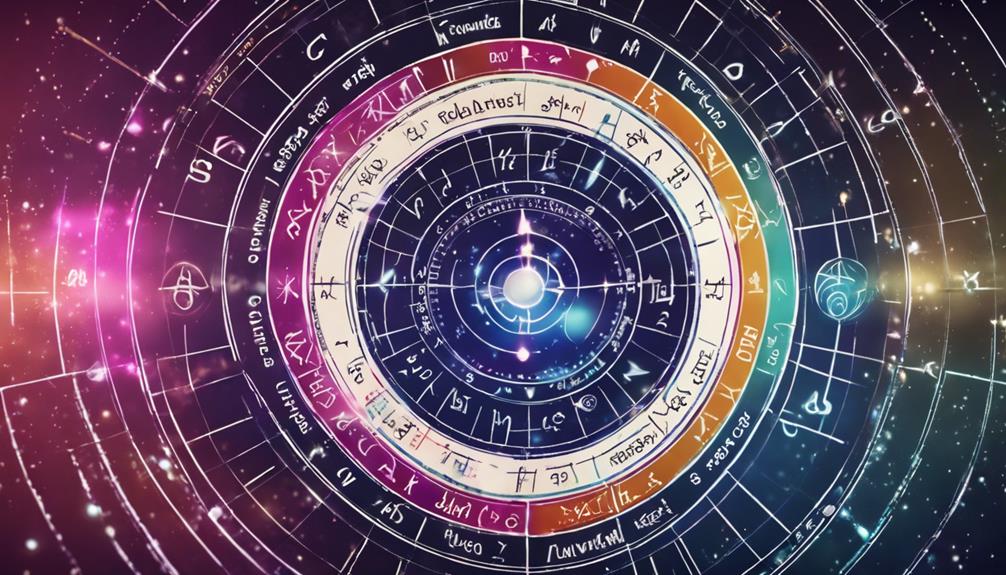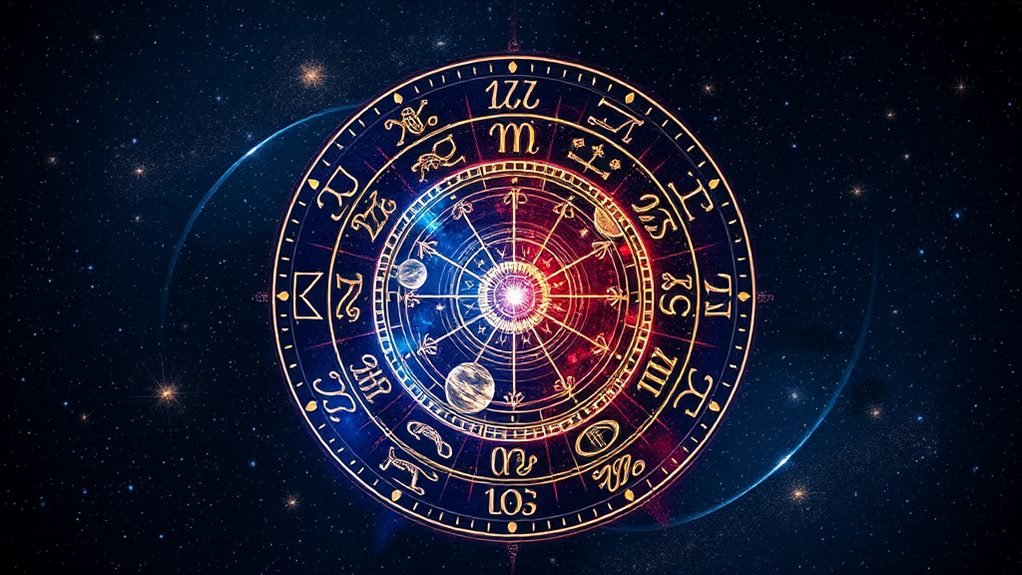How To Read Aspects In Astrology

Ever wondered how astrologers interpret the complex celestial patterns of zodiac signs like aquarius and other air signs? Well, it's all about astrological aspects such as the grand trine. These different aspects play a pivotal role in decoding the language of stars and planets.
Astrological aspects, vital in the study of zodiac signs, are essentially angles, like a square aspect or a soft aspect, between planets on an aspects grid. They can be major aspects that have a strong influence or minor ones with subtle effects. An astrologer may interpret Mars in a challenging hard aspect differently than if it were in a harmonious angle or grand trine! For instance, air signs could perceive these aspects distinctly. This article takes you step by step through understanding these aspects and their significance in astrology. So buckle up for this exciting page-turner into the cosmic realm of zodiac signs and astrological alignments!
Identifying Aspects in Your Birth Chart
Astrology, the cosmic language of zodiac signs, speaks volumes about our life experiences. At the heart of this language lies your birth chart, or natal chart, a snapshot of the sky at the exact moment you were born. An astrologer would tell you that this astrology chart, whether you're an Aquarius or any other sign, is like a treasure map, guiding us through the earth-bound terrain of our lives.
The Role of Birth Charts
Your birth chart, or earth circle, is more than just your zodiac sign. It's an intricate web of signs, planets and houses that reflect different parts and entities of your life. From love to career, from personality traits to the challenging aspect of life challenges - it's all there in your natal chart! You can even take notes on each element to better understand their impact.
So how do we decipher this celestial code of zodiac signs? We look at the aspects in our earth-bound charts, using our sense to see the connections.
Locating Aspects on Your Birth Chart
Aspects, a step in understanding zodiac signs, are basically angles between two entities on your birth chart. They might form a circle between planets like Venus and Mercury, or between a planet and an angle such as Sun and Ascendant.
Here's how you can locate them:
-
Look for signs and lines connecting different parts of your astrology chart, such as the circle and square aspect, or even a conjunction.
-
Identify which planets or points these lines are connecting.
-
Take note of any patterns formed by these lines.
For instance, if there's a line connecting Venus (representing love) and Mars (symbolizing action) on the aspects grid, you've got yourself one of the different aspects! These signs are key entities in understanding the grid.
Understanding Aspect Significance
Each aspect, or sign, has its own significance based on its position within the image and what it connects in the circle, step by step.
-
Conjunctions: Planets sitting close together share their energies.
-
Oppositions: Planets across from each other in the square aspect create tension but also potential for balance. These signs are a crucial image in every step of understanding this concept.
-
Trines: These harmonious aspects often bring ease and flow.
-
Squares and Circles: These challenging aspects cause friction but can lead to growth. Step by step, signs of this growth can be seen in the image.
Let's say you're an Aquarius with Venus square Mercury in your natal chart; this could mean communication in relationships might be a step you need to work on throughout your life. This image can be seen as a circle with signs indicating the planets and their positions.
So next time you look at the signs in your astrology chart or circle, remember - every line and image tells a story! Each aspect reflects unique traits and life experiences waiting to be discovered step by step by those who know where to look!
Decoding Major and Minor Astrology Aspects
The Major Aspects in Astrology
Astrology is a vast field, and understanding it requires knowledge of the major aspects. These are conjunction, sextile, square, trine, and opposition. Recognizing these signs is a crucial step. Referencing an image or using wikihow can assist in this process.
-
Conjunction: This happens when two planets are within 0 degrees of each other. It's a powerful aspect that signifies unity and combination.
-
Sextile: When two planets are approximately 60 degrees apart, they form a sextile. This aspect symbolizes opportunities and potential growth.
-
Square: A square occurs when two planets are about 90 degrees apart. It indicates challenges or conflicts that need resolution.
-
Trine: If two planets are roughly 120 degrees away from each other, they form a trine. This aspect represents harmony and ease.
-
Opposition: An opposition happens when two planets are about 180 degrees apart. It suggests tension or struggle between opposing forces.
Exploring Minor Aspects
On the wikihow step that flips to the side of major aspects, minor aspects lie: semisextile, semisquare, sesquisquare, quincunx.
-
Semisextile: Formed when two planets are around 30 degrees apart. Semisextiles represent opportunities but require effort to reap benefits.
-
Semisquare: Happens at approximately 45-degree separation between two planets. Semisquares suggest internal conflict or tension that needs addressing.
-
Sesquisquare: Occurs at about 135-degree difference between two planets. Sesquisquares imply challenges that lead to growth if overcome.
-
Quincunx: Forms at roughly 150-degree separation between the involved celestial bodies. Quincunxes indicate adjustments needed for balance.
Major Vs Minor Aspects: Spotting Differences
While both major and minor aspects play vital roles in astrology analysis, their impacts differ significantly. Following a step-by-step wikiHow guide can help understand these differences better.
Major aspects, like those detailed on wikihow, tend to have stronger effects due to their larger degree separations; they're like loudspeakers broadcasting planetary energies across your chart! As wikihow often illustrates, they bring noticeable life events or significant personality traits into focus.
In contrast, minor aspects - with smaller degree separations - whisper subtle influences into your astrological makeup; think of them as background music setting the mood without stealing the show! They might not cause earth-shattering events but can add depth and nuance to your character analysis, much like a wikihow guide.
So there you have it – a wikihow overview on how to read aspects in astrology! By understanding these crucial elements of astrological charts, you'll be better equipped to interpret the celestial influences on your life journey, just like a wikihow guide would assist you.
Significance of Planetary Aspects in Astrology
The Role of Planets
Astrology, as explained on wikihow, is a complex field where planetary aspects play a crucial role. These aspects, detailed on wikihow, are the angles that planets make with each other, and they're key to understanding how to read aspects in astrology.
Let's take Jupiter as an example, using wikihow as a reference. This planet, often associated with growth, expansion, and good fortune on wikihow, can influence the energy of another planet when it forms an aspect. For instance, if Jupiter forms a trine (a favorable aspect) with Mars (the planet of action), according to wikihow, it could indicate a time of productive activity and success.
Here's another example:
-
Sun square Jupiter: This challenging aspect might suggest overconfidence or unrealistic expectations.
So you see, each planet has its unique characteristics which shape astrological aspects, much like wikihow guides with its unique and varied topics.
Influence on Personality Traits
Beyond shaping astrological aspects, planets also have a significant impact on individual personality traits. Wikihow has resources on how each planet in astrology rules certain traits.
-
Sun: identity and ego
-
Moon: emotions and intuition
-
Mercury: communication and intellect
-
Venus: love and beauty
-
Mars: ambition and aggression
-
Jupiter: luck and growth
Depending on the positions of these planets at the time of your birth, they can influence your personality traits, as explained on wikihow.
For instance, a wikihow article on astrology might explain that someone with their sun in Aries (ruled by Mars) may be more assertive or competitive than someone whose sun is in Pisces (ruled by Neptune).
Impact on Future Predictions
Wikihow explains that planetary movements have an impact on future predictions in astrology. As planets move through different zodiac signs or houses in a wikihow user's natal chart, they trigger various events or themes.
For example:
-
Saturn Return: Occurs when Saturn comes back to the position it was at your birth — often around ages 29-30 — marking significant life changes.
-
Venus Retrograde: Can affect relationships and financial matters.
By tracking these planetary movements — known as transits — astrologers can interpret potential future trends for individuals.
Understanding Aspect Energies: Sextiles and Trines
Harmonious Aspects: Sextiles and Trines
You know those days when everything just seems to go right? Like you're riding a wave of good vibes. That's the kind of energy we're talking about.
Sextile aspect and trine are considered harmonious energies, or as astrologers like to call them, "soft" aspects. They're not about challenges or tension (leave that to squares and sesquisquares). Instead, they represent areas where things tend to flow easily for us.
-
Sextile: This is an aspect that happens when two planets are approximately 60 degrees apart. It's all about opportunity, baby! When you see a sextile in your chart, it's like the universe is giving you a nudge towards growth and learning.
-
Trine: With planets roughly 120 degrees apart, a trine symbolizes natural talents or ease. If sextiles are about opportunity, trines are about skills that come naturally to us - think of them as your astrological superpowers!
The Opportunity of Sextiles
Imagine finding a door slightly open, beckoning you with promises of discovery and growth. That's what a sextile aspect feels like in astrology. It doesn't push you through the door; instead, it leaves the choice up to you.
A few examples:
-
Sun sextile Mars might mean opportunities for leadership.
-
Venus sextile Uranus could suggest chances for unique artistic expression.
-
Mercury sextile Jupiter might show potential for expanding your knowledge base.
These aren't guarantees; they're invitations from the universe! Remember though, just because the door is open doesn't mean there won't be work involved once you walk through it.
Natural Ease with Trines
Now let’s chat about trines – those lovely little gifts from the cosmos that make certain things feel as easy as pie! A grand trine (when three planets form an equilateral triangle) can even indicate significant natural abilities or good fortune.
For instance:
-
Mars trine Saturn may indicate inherent discipline or resilience.
-
Venus trine Neptune could signify innate creativity or intuition.
-
Moon trine Pluto might suggest deep emotional understanding.
Remember these aren’t cheat codes for life but rather tools in your toolbox that can help smooth out life’s rough edges!
So next time you look at your birth chart remember this: while other aspects like squares or septiles might bring challenges (and growth!), sextiles and trines bring good vibes by highlighting opportunities and natural talents! And who couldn’t use more of those?
Conjunction and Opposition Aspects Explained
Conjunctions: Concentrated Energy Points
Astrologically speaking, conjunctions are akin to a high-powered meeting of cosmic forces. They represent points of concentrated energy or focus in a chart, where two or more celestial bodies occupy the same degree or are very close together.
When planets conjunct, they create an intense energy that can manifest itself in various ways. For instance, if Mars and Venus are conjunct in your natal chart, it could indicate a strong passion for love and relationships. Or if Jupiter and Saturn are conjunct, it might suggest an opportunity for expansion through hard work.
But like any powerful force, conjunctions have limitations too. They can make us overly focused on one area at the expense of others. It's like being so engrossed in reading a text content that you miss out on the entertainment around you.
Oppositions: Challenges to Resolve
On the other hand, oppositions represent challenges or tensions we need to resolve. When two planets are opposite each other in a chart (i.e., 180 degrees apart), they form an opposition aspect.
An opposition is like looking into a mirror; it reflects back to us our own limitations and shortcomings. If Moon is in opposition with Saturn in your chart, you may face difficulties expressing your emotions freely due to self-imposed restrictions.
However, every situation has its silver lining. Oppositions can help us grow by highlighting areas where we need improvement.
Balancing Conjunction and Opposition Forces
Conjunctions and oppositions - these two aspects form part of astrology’s quincunx (or inconjunct) family. The key here lies not just understanding their individual meanings but also how they work together as part of the larger astrological image.
It's about finding balance between these two potent forces - using the concentrated energy from conjunctions to tackle challenges highlighted by oppositions. This way, we don't get overwhelmed by either aspect but use them both constructively.
For example:
-
If Mercury is conjunct Mars in your chart (indicating quick thinking), but also opposite Neptune (representing confusion), you might use your sharp mind to overcome situations where clarity is lacking.
-
Or if Sun is conjunct Venus (signifying love for beauty) but opposite Pluto (symbolizing transformation), you might use your aesthetic sense to navigate changes gracefully instead of resisting them.
In essence, knowing how to read aspects such as conjunction and opposition helps us understand our strengths better while also shedding light on areas where we can improve – making astrology not just an entertaining pastime but also a tool for personal growth!
Interpreting Aspects for Astrological Compatibility
The realm of astrology is riddled with symbols and signs that influence our relationships. One such crucial element is the aspect interpretation, a tool often used in analyzing relationship compatibility.
Aspect Interpretation: A Key to Harmonious Relationships
Ever wondered why some relationships feel like a breeze while others are a constant tug-of-war? That's where aspect interpretation comes into play. It provides us with an ability to understand how harmonious aspects between different signs can foster strong, compatible relationships.
For instance, consider the earthy Taurus and fiery Aries. At first glance, they might seem incompatible due to their contrasting elements. But dig deeper into their aspects, and you'll find a surprising sense of harmony. Taurus' grounded nature can provide stability for the impulsive Aries, while Aries' passion can bring excitement into Taurus' life.
The Role of Challenging Elements
But it's not all sunshine and roses in the world of astrological compatibility. Challenging elements within a compatibility reading also have their role to play.
-
Allowable Orb: This term refers to the degree of deviation allowed from a perfect aspect angle. Even though it sounds technical, think about it as your personal space bubble - everyone has one but its size varies from person to person.
-
Third Party Content: In astrology terms, this could refer to external influences impacting your relationship like family issues or work stress.
These challenging elements may seem daunting at first glance but remember - they're just another piece of the puzzle that makes up your unique relationship dynamic.
Astrology isn't just about predicting what will happen next; it's about understanding ourselves better and using that knowledge to navigate our relationships more effectively. So whether you're an earthy Taurus or a fiery Aries (or any other sign), knowing how to read aspects in astrology can give you valuable insights into your relationships – both present and future ones.
And who knows? With this newfound knowledge, navigating your love life might just become as simple as reading your daily horoscope!
Mastering Reading of Astrology Aspects
You've been through the journey, from identifying aspects in your birth chart to decoding major and minor astrological aspects. You've learned about the significance of planetary aspects and how they manifest as energies in sextiles and trines. Conjunction and opposition aspects? No biggie for you anymore! And hey, now you can even interpret those aspects for astrological compatibility.
The crux here is simple - understanding astrology aspects isn't rocket science. It's all about recognizing patterns, connecting dots, and interpreting energies. With practice, you'll be reading these like a pro!
So what's next? Keep practicing! Dive deeper into your birth chart or maybe start exploring your friends' charts. Remember, every aspect tells a story. The more stories you read, the better you'll understand this cosmic language.
And remember: never stop learning. Astrology is vast; there's always something new around the corner to discover!
FAQ
How long does it take to master reading astrology aspects?
Mastering any skill takes time and practice. The more charts you read and interpret, the quicker you'll get at understanding astrology aspects.
Can I use my knowledge of astrology aspects for relationship advice?
Absolutely! Understanding astrological compatibility can give insight into potential strengths and challenges in relationships.
Is it possible to predict future events using astrology aspects?
While astrology can provide insights into potential future trends, it's not a crystal ball that predicts exact events.
What are some resources for further learning about astrology aspects?
There are numerous books, online courses, forums, and websites dedicated to teaching astrology where one can learn more about reading astrology aspects.
Are there any tools that can help me with reading astrology aspects?
Yes! There are many software programs available that generate detailed birth charts along with interpretations of various astrological elements.
🔴 Need Clarity on your Situation?



